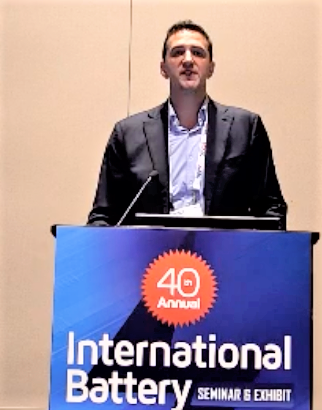While industry analysts are still mostly bullish about the battery market, which is primarily linked to demand for electric cars, a word of caution comes from Andrew Miller, chief operating officer of Benchmark Mineral Intelligence.
Speaking at the recent International Battery Seminar, Miller asserts that “Rising lithium prices and turbulence around the nickel industry are warning signs of what is facing this industry in the years to come. We’re in the early stages of this scale-up, and what’s happening in lithium and in nickel should serve as case studies for what the industry could face if we don’t start acting to solve some of these bottleneck constraints.
“All of this is being compounded by what’s occurring at a policy level,” he adds.
Miller (pictured, below left) singles out the Inflation Reduction Act as a legislative milestone. “We’re now seeing the scramble by other countries and regions such as the European Union to keep pace, protect their domestic industry and remain competitive in this push toward electrification.
 “All of these forces are now converging around the electric-vehicle market,” he says.
“All of these forces are now converging around the electric-vehicle market,” he says.
Benchmark is projecting global electrified-vehicle sales, combined battery-electrics and plug-in hybrids, of 14 million units in 2023. In the battery segment, it predicts demand will grow to 960 GWh, counting, in addition to EVs, portable electronics and stationary storage units.
“But we actually expect battery production to overtake that level this year and break the 1-TWh threshold for the first time,” says Miller. “Compare that to 60 GWh in 2015. So, growth has been massive.
“Continued growth is contingent on midstream processing, anode and cathode production, refining of raw materials and extraction of those raw materials out of the ground,” Miller notes. “All of these supply chain links are going to have to be in place at scale and at the speed we’re seeing Li-ion battery production to sustain these growth levels.”
While acknowledging significant economies of scale have been achieved by reaching 1-TWh production levels, the Benchmark executive cautions: “We are facing a cliff edge in terms of the availability of these raw materials. If we don’t start to commit significant amounts of capital into the supply chain, we will be faced with severe supply constraints come the latter half of the decade.”
Benchmark estimates global demand will approach 3 TWh in 2030. “If raw materials become a constraint,” Miller warns, “the industry will have to adapt. Does the nature of an electric vehicle going 300-plus (483 km) miles have to change? Do we introduce new chemistries?”
Turning his attention to the North American market, Miller estimates that meeting 2035 demand will require 3.3 million additional tons of lithium to 4.0 million tons, 3.0 million more tons of nickel to 6.2 million tons and 312,000 additional tons of cobalt to 489,000 tons.
Miller doesn’t reveal Benchmark’s 2035 forecast, but he indicates that to produce 20 TWh of Li-ion batteries requires 12 million tons of lithium, 8 million tons of nickel, 2 million tons of manganese and 1 million tons of cobalt.
Against this backdrop, he reports that while North America will produce 100% of battery cells needed to meet battery demand in 2030, it is a different story when looking at raw material sourcing, chemical refining and production, and cathode and anode production.
“North America has a long way to go to displace Chinese supply chain dominance,” he says.
With respect to raw material sourcing, Benchmark expects domestic sourcing to reach the following shares of domestic demand – in all cases far short of 100%:
- Mined lithium: 61%.
- Mined cobalt: 14%.
- Refined nickel: 59%.
- Flake graphite (400 grade): 19%.
In the case of chemical refining and production:
- Lithium hydroxide and lithium carbonate: 54%.
- Refined cobalt: 21%.
- Nickel sulphate: 5%.
- Manganese sulphate (high purity): 14%.
- Spherical graphite: 26%.
- Synthetic graphite for anodes: 30%.
With respect to cathode and anode production, the challenge is more daunting, with the North American supply share at 4% and 3%, respectively.
“When we look at the breakdown of battery cell cost,” says Miller, “the biggest drivers are coming from cathodes, anodes and raw materials, the nickels, the cobalts, the graphites of the world, which are really at the heart of EV economics. If we want to keep (cell) costs at the $100/kWh level, end users will have to be more involved with upstream supply.”
Can the market meet future demand?
“The Inflation Reduction Act is a hugely ambitious piece of legislation,” he says. “It sets us on an incredibly important trajectory. But if we look at the realities of the market, we have to be aware that we can’t do all of this in one fell swoop.
“We’ve done pretty well in terms of installing enough battery production capacity to theoretically meet the demand of the region, Miller adds. “But as we work upstream, what we realize is that we can’t meet that type of capacity, certainly not in the near term.
“And there are parts of this supply chain where North America isn’t going to be competitive. We can’t change geology. We can’t change what's in the ground.
“The scale facing this industry is massive,” he concludes, “even if we’re at half the rate. We’re faced with a huge amount to do in a relatively short amount of time.”





